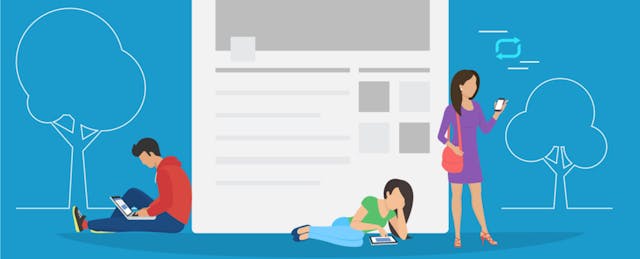Since 2011 Banned Books Week has included a day to recognize banned websites. This year, on September 27, 2017, the American Association of School Librarians made a point to encourage their members to raise awareness about “overly restrictive blocking of legitimate, educational websites and academically useful social networking tools in schools and school libraries.”
Librarians are not the only ones calling out censorship. Teachers and principals also increasingly voice opposition to blocking social websites, noting that schools have an obligation to teach students how to use social media responsibly. They say that though the Children’s Internet Protection Act (a law put in place by the federal government 2000) requires schools to filter content such as pornography or other explicit subjects, districts have gone too far, filtering websites with valuable learning opportunities using the law as justification.
“For librarians, we see that when you are filtering out legitimate websites and some of the social media sites, you’re taking away the chance to build capacity for students to use them effectively and responsibly,” said Steven Yates, president of the American Association of School Librarians. “If you remove the chance for those websites to be used in school, then where are we developing those responsible habits for our students? How can we have an impact on developing digital citizenship skills?”
Several educators echo Yates’ comments. Learning how to behave online responsibly and safely—a concept known as digital citizenship—requires access to social media tools in schools, they note. Darren Ellwein, a principal at Harrisburg South Middle School in South Dakota, says that since his district opened channels such as Facebook and YouTube, the sites have become vital learning sources for their students.
“We like to have things wide open,” explains Ellwein, who was also named as one of several “Digital Principals of the Year” by the National Association of Secondary School Principals. “We truly believe that educating on the digital citizenship is a really big responsibility for us. If we block it, we are saying it is not important.” He uses digital citizenship lessons from Common Sense Education, noting that his school “lives by” the content. “Social media is already a part of their frameworks as teens. They are all into it. If we block it, we have no chance to educate them on it,” he continues.
Ellwein’s school uses several social media platforms, which are only blocked during testing periods. At other times, his school interacts with three sister schools in Norway via Facebook groups, where teachers pose questions and students from Norway and South Dakota can respond, discuss and compare experiences. They also invite in experts into the Facebook groups who can guide dialog or answer student questions. On YouTube teachers create channels where they post lessons that students can access at home. Students are also allowed to search for information on YouTube and listen to music while they work.
“We run personalized learning over here, and a part of the norms our kids have created for themselves is listening one earbud in one earbud out, but still focusing on what our content is,“ Ellwein explains. He believes that the future of learning and global education exchanges will be dependant on social media.
Clay Smith, a ninth-grade computer science teacher from New York City, previously taught in a school that unblocked YouTube, but now works in a school where it is blocked. He, like Ellwein, fears that educators may not be reaching students through the mediums that feel natural and convenient to them if websites remain blocked.
With YouTube, “I am working with it in the capacity that students would in the real world,” explains Smith. “That can mean creating content for self-help videos or using it to get information for students to teach themselves. Now it is more of a struggle because I have to describe these skills to them, tell them to go home and do things. When they run into problems, I cannot troubleshoot.”
Smith does have reservations, however. He doesn’t want YouTube unblocked at all times, noting how students can be easily distracted. Instead, he hopes that individual educators can have more control over when to block or unblock websites at school.
Today in New York City, if an educator wants to use YouTube or other blocked sites in the classroom, they have to fill out a form, get approval from the principal, and send the request to the city’s Department of Education. The process may seem arduous but is lax when compared to other districts, where the entire district must agree to block or unblock a website across all its schools.
Smith also acknowledges the proliferation of bullying through social media, noting how the ability for students to send unmonitored messages to one another on platforms such as Facebook could have dangerous consequences.
“Facebook is very interesting for the social interaction that should be happening versus what is happening. There’s far more cyberbullying out there,” says Smith. “Students in different classes could be talking to each other online, and that could lead to a fight.”
Derek McCoy, a principal at West Rowan Middle School in North Carolina, is willing to take the risk. His district currently blocks YouTube, Facebook and other social networking sites. However, he is advocating for those blocks to be removed, noting how access to information is transforming.
“When I was growing up, I had a textbook, and we still got off track. The medium doesn’t change what a middle-schooler does or doesn’t do. We have to be ready as educators to redirect as needed and support students throughout the learning process,” McCoy explains.
“We cannot be governed by fear,” he adds. “When anyone does something wrong online, we cannot put on our alarmist hats. We must keep learning first.”


